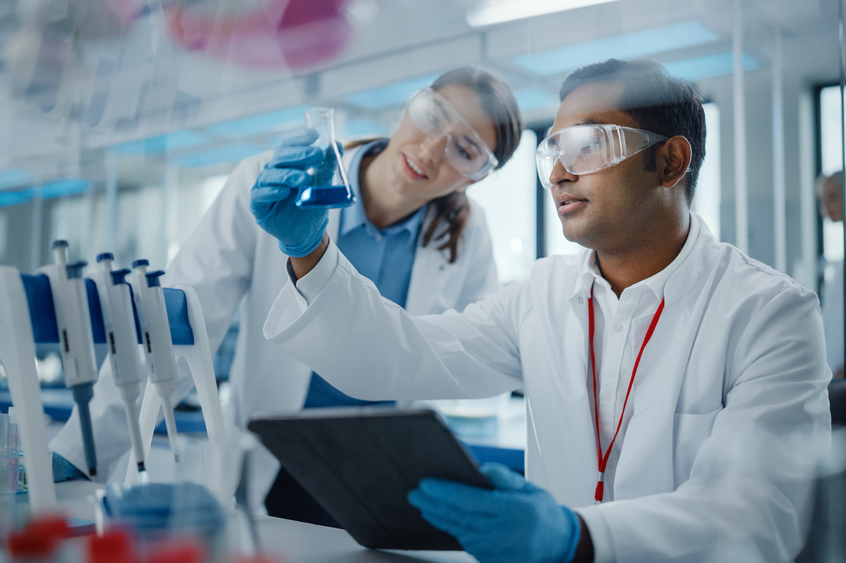Synthetic biology is an emerging medical field offering applications for diagnostics, therapeutics, and vaccine development for multiple diseases.
Current diagnostics for infectious bacterial diseases are often slow to provide results, delaying appropriate care. Meanwhile, many types of bacteria have become resistant to existing antibiotics in recent years.
Synthetic biology has the potential to overcome these challenges. This technology is therefore hugely important, especially given the increased emergence of new infectious diseases. The global synthetic biology market is expected to reach more than $55 million by 2030 due to growing demand, particularly for personalized medicine.1
What is synthetic biology?
Synthetic biology uses a combination of biology, engineering, genetics, chemistry, and computer science to alter the function and structure of microorganisms such as bacteria. Genetically altered bacteria, referred to as synthetic biotics, can be created using new or redesigned biological parts, which are DNA sequences that encode for biological functions such as transporting oxygen throughout the human body. These newly created DNA sequences are then inserted into an organism’s genome.
A synthetic biotic is made up of the following components: a chassis organism, one or more genetic components such as engineered DNA sequences, and other ancillary elements such as transporters. Commensal bacteria, such as laboratory-developed strains of Escherichia coli (E.coli), are frequently used as the chassis because they are known to the U.S. Food and Drug Administration (FDA) and the European Medicines Agency (EMA) and are therefore more likely to be approved for use in synthetic biotics.2
The method of administration, which can be through topical skin application or by intra-dermal injection, also requires consideration. The subsequent eradication of the synthetic biotic upon drug delivery is critical as well; genetically altered bacteria is engineered to have no antibiotic resistance and can be destroyed following antibiotic delivery.
Diagnostic tests
Delayed identification of infective bacteria in the diagnosis of disease can result in inappropriate antibiotic treatment and ultimately lead to early mortality, particularly from sepsis. Mortality following inappropriate antibiotic treatment is reportedly as high as 30-39%. In contrast, appropriate antibiotic treatment drops this to 12-28%. Traditionally, culturing bacteria to diagnose disease and enable appropriate antibiotic treatment can take 24-48 hours or more. Synthetic biology diagnostics can quickly and accurately identify bacterial infections and speed up this time to diagnosis. 3
Bacteriophages, more commonly referred to as phages, are viruses that destroy bacteria. Genetically engineered phages, called fluoromycobacteriophages, have been developed for phage-based diagnostics to identify pathogens such as Staphylococcus aureus, Listeria, E. coli, and Bacillus anthracis (anthrax). Engineered phages also can significantly shorten pathogen detection time. For example, culturing tuberculosis (TB), which can typically take up to 10 weeks, requires as little as 48 hours using this new method.
FastPlaque TB and FastPlaque-Response assays are both commercially available phage-based diagnostic platforms, with reported sensitivity of 95% and specificity of 97%, that can identify TB and determine if the TB strain is resistant to the antibiotic rifampicin. KeyPath, an FDA-approved methicillin-resistant S. aureus (MRSA)/methicillin-susceptible S. aureus (MSSA) blood culture test, can detect S. aureus and differentiate MRSA in 5.5 hours, compared to current methods of culturing S. aureus that can take more than 48 hours. This test has a sensitivity and specificity of 91.8% and 98.3%, respectively.3
Researchers have developed a new low-cost and rapid diagnostic tool to detect Zika virus. This technology uses toehold switches, a class of engineered RNAs suited for biomedical diagnostics, to detect Zika virus’s RNA genome in a freeze-dried, paper-based platform. Paper-based platforms can be preserved for more than a year at room temperature before being reactivated upon rehydration.4 Synthetic biology-based diagnostic tests are also under development to quickly diagnose infectious diseases such as fungal sepsis and pneumonia, which can take more than 48 hours to diagnose with a culture test. Additional new methods include bioluminescent reporter phages, which can reduce the diagnosis time of bacterial infection to minutes.3
Whole-cell biosensors are devices made up of engineered bacterial cells that respond to targeted chemicals. They have potential uses in individual health monitoring via wearable materials or breath samples. Applications for such portable biosensors could include disease detection and alerting medical personnel to signs of ill health. Synthetic biology developments also include materials used in wound healing that can sense and fight bacterial infections such as MRSA.5
Therapeutics
Bacterial therapeutics are classified as live biotherapeutic products (LBPs). They are live organisms designed to treat, cure, or prevent a disease, but do not include vaccines. Genetically modified bacteria are considered biological agents and are classified as recombinant LBPs, which the FDA regulates through the Center for Biologics Evaluation and Research.2
One of the biggest developments in synthetic biology therapeutics has occurred in the treatment of malaria. Artemisinic acid derived from the plant Artemisia annua (known as sweet woodworm) is purified and converted into artemisinin to make anti-malaria drugs. Scientists also are modifying the metabolic pathways of Saccharomyces cerevisiae, better known as baker’s yeast, to convert sugars to artemisinic acid to make artemisinin. As a result, anti-malaria drugs can now be produced on a much larger scale, lowering the overall cost of production.7
The bacteria Salmonella has been genetically engineered to trigger the immune system to attack cancer cells. Since bacteria reside in cancer cells, they are an ideal vessel for pharmaceuticals to target specific sites in the body. Initial in vivo tests show that this treatment destroys 60% of tumors.7
Proteins can now be modified to create new therapeutics, including the treatment of phenylketonuria (PKU). A rare inherited disorder caused by a genetic defect, the disease decreases the metabolism of the amino acid phenylalanine (Phe),1 which leads to serious health problems. Advances in synthetic biology hold the potential to break down Phe with an orally administered synthetic biotic named SYNB1618, which is a derivative of the E. coli strain Nissle 1917. Currently, the treatment is in phase 2 clinical trials to assess its efficacy and safety in adults with PKU.2




